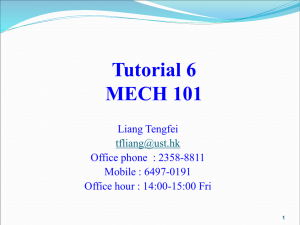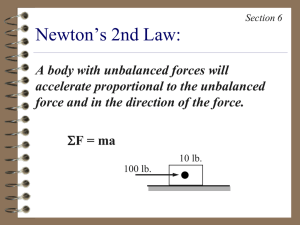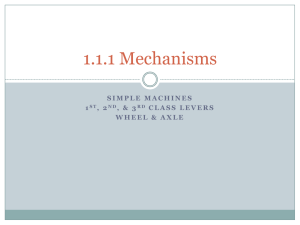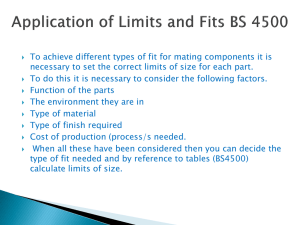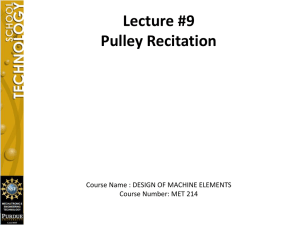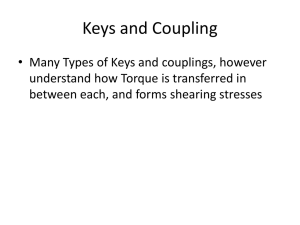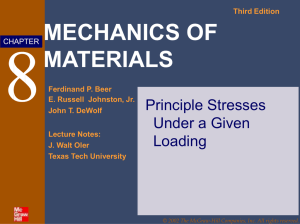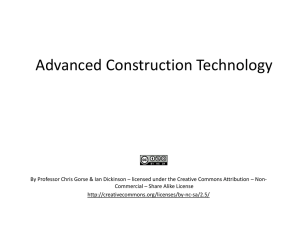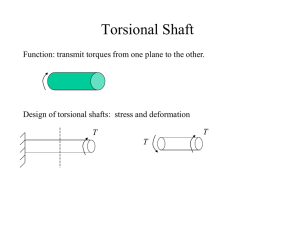Torsion
advertisement
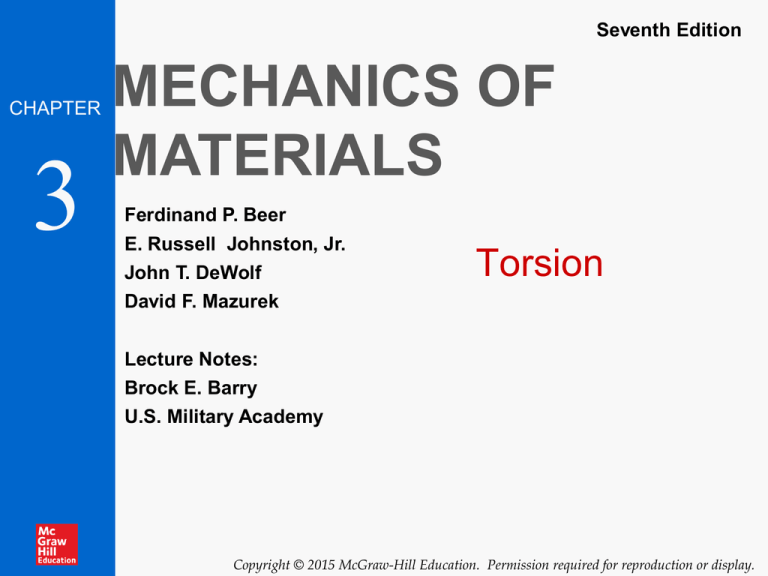
Seventh Edition CHAPTER 3 MECHANICS OF MATERIALS Ferdinand P. Beer E. Russell Johnston, Jr. John T. DeWolf David F. Mazurek Torsion Lecture Notes: Brock E. Barry U.S. Military Academy Copyright © 2015 McGraw-Hill Education. Permission required for reproduction or display. Seventh Edition MECHANICS OF MATERIALS Beer • Johnston • DeWolf • Mazurek Contents Torsional Loads on Circular Shafts Statically Indeterminate Shafts Net Torque Due to Internal Stresses Sample Problem 3.4 Axial Shear Components Design of Transmission Shafts Shaft Deformations Stress Concentrations Shearing Strain Plastic Deformations Stresses in Elastic Range Elastoplastic Materials Normal Stresses Residual Stresses Torsional Failure Modes Concept Application 3.8/3.9 Sample Problem 3.1 Torsion of Noncircular Members Angle of Twist in Elastic Range Thin-Walled Hollow Shafts Concept Application 3.10 Copyright © 2015 McGraw-Hill Education. Permission required for reproduction or display. 3-2 Seventh Edition MECHANICS OF MATERIALS Beer • Johnston • DeWolf • Mazurek Torsional Loads on Circular Shafts • Stresses and strains in members of circular cross-section are subjected to twisting couples or torques • Turbine exerts torque T on the shaft • Shaft transmits the torque to the generator • Generator creates an equal and opposite torque T’ Fig. 3.2 (a) A generator provides power at a constant revolution per minute to a turbine through shaft AB. (b) Free body diagram of shaft AB along with the driving and reaction torques on the generator and turbine, respectively. Copyright © 2015 McGraw-Hill Education. Permission required for reproduction or display. 3-3 Seventh Edition MECHANICS OF MATERIALS Beer • Johnston • DeWolf • Mazurek Net Torque Due to Internal Stresses Fig. 3.3 Shaft subject to torques and a section plane at C. • Net of the internal shearing stresses is an internal torque, equal and opposite to the applied torque, T dF dA • Although the net torque due to the shearing stresses is known, the distribution of the stresses is not. • Distribution of shearing stresses is statically indeterminate – must consider shaft deformations. Fig. 3.24 (a)Free body diagram of section BC with torque at C represented by the representable contributions of small elements of area carrying forces dF a radius from the section center. (b) Free-body diagram of section BC having all the small area elements summed resulting in torque T. • Unlike the normal stress due to axial loads, the distribution of shearing stresses due to torsional loads cannot be assumed uniform. Copyright © 2015 McGraw-Hill Education. Permission required for reproduction or display. 3-4 Seventh Edition MECHANICS OF MATERIALS Beer • Johnston • DeWolf • Mazurek Axial Shear Components • Torque applied to shaft produces shearing stresses on the faces perpendicular to the axis. Fig. 3.5 Small element in shaft showing how shear stress components act. • Conditions of equilibrium require the existence of equal stresses on the faces of the two planes containing the axis of the shaft. • The existence of the axial shear components is demonstrated by considering a shaft made up of slats pinned at both ends to disks. • The slats slide with respect to each other when equal and opposite torques are applied to the ends of the shaft. Fig. 3.6 Model of shearing in shaft (a) undeformed; (b) loaded and deformed. Copyright © 2015 McGraw-Hill Education. Permission required for reproduction or display. 3-5 Seventh Edition MECHANICS OF MATERIALS Beer • Johnston • DeWolf • Mazurek Shaft Deformations • From observation, the angle of twist of the shaft is proportional to the applied torque and to the shaft length. T L Fig. 3.7 Shaft with fixed support and line AB drawn showing deformation under torsion loading: (a) unloaded; (b) loaded. • When subjected to torsion, every cross-section of a circular shaft remains plane and undistorted. • Cross-sections for hollow and solid circular shafts remain plain and undistorted because a circular shaft is axisymmetric. Fig. 3.8 Comparison of deformations in circular (a) and square (b) shafts. • Cross-sections of noncircular (nonaxisymmetric) shafts are distorted when subjected to torsion. Copyright © 2015 McGraw-Hill Education. Permission required for reproduction or display. 3-6 Seventh Edition MECHANICS OF MATERIALS Beer • Johnston • DeWolf • Mazurek Shearing Strain • Consider an interior section of the shaft. As a torsional load is applied, an element on the interior cylinder deforms into a rhombus. • Since the ends of the element remain planar, the shear strain is equal to angle of twist. • It follows that L or L • Shear strain is proportional to twist and radius max Fig. 3.13 Shearing Strain Kinematic definitions for torsion deformation. (a) The angle of twist (b) Undeformed portion of shaft of radius with (c) Deformed portion of the shaft having same angle of twist, and strain, angles of twist per unit length, . c and max L c Copyright © 2015 McGraw-Hill Education. Permission required for reproduction or display. 3-7 Seventh Edition MECHANICS OF MATERIALS Beer • Johnston • DeWolf • Mazurek Stresses in Elastic Range • Multiplying the previous equation by the shear modulus, G c G max From Hooke’s Law, G , so Fig. 3.14 Distribution of shearing stresses in a torqued shaft; (a) Solid shaft, (b) hollow shaft. c max The shearing stress varies linearly with the distance from the axis of the shaft. • Recall that the sum of the moments of the elementary forces exerted on any cross section of the shaft must be equal to the magnitude T of the torque: T dA max 2 dA max J c c • The results are known as the elastic torsion formulas, max Tc T and J J Copyright © 2015 McGraw-Hill Education. Permission required for reproduction or display. 3-8 Seventh Edition MECHANICS OF MATERIALS Beer • Johnston • DeWolf • Mazurek Normal Stresses Fig. 3.17 Circular shaft with stress elements at different orientations. • Elements with faces parallel and perpendicular to the shaft axis are subjected to shear stresses only. Normal stresses, shearing stresses or a combination of both may be found for other orientations. • Consider an element at 45o to the shaft axis, F 2 max A0 cos 45 max A0 2 45o Fig. 3.18 Forces on faces at 45° to shaft axis. Fig. 3.19 Shaft elements with only shear stresses or normal stresses. F max A0 2 max A A0 2 • Element a is in pure shear. • Element c is subjected to a tensile stress on two faces and compressive stress on the other two. • Note that all stresses for elements a and c have the same magnitude. Copyright © 2015 McGraw-Hill Education. Permission required for reproduction or display. 3- 9 Seventh Edition MECHANICS OF MATERIALS Beer • Johnston • DeWolf • Mazurek Torsional Failure Modes Photo 3.2 Shear failure of shaft subject to torque. • Ductile materials generally fail in shear. Brittle materials are weaker in tension than shear. • When subjected to torsion, a ductile specimen breaks along a plane of maximum shear, i.e., a plane perpendicular to the shaft axis. • When subjected to torsion, a brittle specimen breaks along planes perpendicular to the direction in which tension is a maximum, i.e., along surfaces at 45o to the shaft axis. Copyright © 2015 McGraw-Hill Education. Permission required for reproduction or display. 3 - 10 Seventh Edition MECHANICS OF MATERIALS Beer • Johnston • DeWolf • Mazurek Sample Problem 3.1 SOLUTION: • Cut sections through shafts AB and BC and perform static equilibrium analyses to find torque loadings. Shaft BC is hollow with inner and outer diameters of 90 mm and 120 mm, respectively. Shafts AB and CD are solid and of diameter d. For the loading shown, determine (a) the minimum and maximum shearing stress in shaft BC, (b) the required diameter d of shafts AB and CD if the allowable shearing stress in these shafts is 65 MPa. • Apply elastic torsion formulas to find minimum and maximum stress on shaft BC. • Given allowable shearing stress and applied torque, invert the elastic torsion formula to find the required diameter. Copyright © 2015 McGraw-Hill Education. Permission required for reproduction or display. 3 - 11 Seventh Edition MECHANICS OF MATERIALS Beer • Johnston • DeWolf • Mazurek Sample Problem 3.1 SOLUTION: • Cut sections through shafts AB and BC and perform static equilibrium analysis to find torque loadings. Fig. 1 Free-body diagram for section between A and B. Fig. 2 Free-body diagram for section between B and C. M x 0 6 kN m TAB M x 0 6 kN m 14 kN m TBC TAB 6 kN m TCD TBC 20 kN m Copyright © 2015 McGraw-Hill Education. Permission required for reproduction or display. 3 - 12 Seventh Edition MECHANICS OF MATERIALS Beer • Johnston • DeWolf • Mazurek Sample Problem 3.1 • Apply elastic torsion formulas to find minimum and maximum stress on shaft BC. Fig. 3 Shearing stress distribution on cross section. J c24 c14 0.060 4 0.045 4 2 2 • Given allowable shearing stress and applied torque, invert the elastic torsion formula to find the required diameter. Fig. 4 Free-body diagram of shaft portion AB. 13 .92 10 6 m 4 max 2 TBC c2 20 kN m 0.060 m J 13 .92 10 6 m 4 max Tc Tc J c4 2 min 86.2 MPa min 64.7 MPa 45 mm 60 mm 6 kN m c3 2 c 38.9 10 3 m 86 .2 MPa min c1 max c2 65 MPa d 2c 77.8 mm max 86.2 MPa min 64.7 MPa Copyright © 2015 McGraw-Hill Education. Permission required for reproduction or display. 3 - 13 Seventh Edition MECHANICS OF MATERIALS Beer • Johnston • DeWolf • Mazurek Angle of Twist in Elastic Range • Recall that the angle of twist and maximum shearing strain are related, max c L • In the elastic range, the shearing strain and shear are related by Hooke’s Law, Fig. 3.20 Torque applied to fixed end shaft resulting angle of twist . max max G Tc JG • Equating the expressions for shearing strain and solving for the angle of twist, TL JG • If the torsional loading or shaft cross-section changes along the length, the angle of rotation is found as the sum of segment rotations Fig. 3.21 Shaft with multiple cross-section dimensions and multiple loads. Ti Li i J i Gi Copyright © 2015 McGraw-Hill Education. Permission required for reproduction or display. 3 - 14 Seventh Edition MECHANICS OF MATERIALS Beer • Johnston • DeWolf • Mazurek Statically Indeterminate Shafts • Given the shaft dimensions and the applied torque, we would like to find the torque reactions at A and B. • From a free-body analysis of the shaft, TA TB 90 lb ft which is not sufficient to find the end torques. The problem is statically indeterminate. • Divide the shaft into two components which must have compatible deformations, 1 2 TAL1 TB L2 0 J1G J 2G LJ TB 1 2 TA L2 J1 • Substitute into the original equilibrium equation, Fig. 3.25 (a) Shaft with central applied torque and fixed ends. (b) free-body diagram of shaft AB. (c) Free-body diagrams for solid and hollow segments. LJ TA 1 2 TA 90 lb ft L2 J1 Copyright © 2015 McGraw-Hill Education. Permission required for reproduction or display. 3 - 15 Seventh Edition MECHANICS OF MATERIALS Beer • Johnston • DeWolf • Mazurek Sample Problem 3.4 SOLUTION: • Apply a static equilibrium analysis on the two shafts to find a relationship between TCD and T0 . • Apply a kinematic analysis to relate the angular rotations of the gears. • Find the maximum allowable torque on each shaft – choose the smallest. Two solid steel shafts are connected by gears. Knowing that for each shaft • Find the corresponding angle of twist G = 11.2 x 106 psi and that the for each shaft and the net angular allowable shearing stress is 8 ksi, rotation of end A. determine (a) the largest torque T0 that may be applied to the end of shaft AB, (b) the corresponding angle through which end A of shaft AB rotates. Copyright © 2015 McGraw-Hill Education. Permission required for reproduction or display. 3 - 16 Seventh Edition MECHANICS OF MATERIALS Beer • Johnston • DeWolf • Mazurek Sample Problem 3.4 SOLUTION: • Apply a static equilibrium analysis on the two shafts to find a relationship between TCD and T0 . • Apply a kinematic analysis to relate the angular rotations of the gears. Fig. 2 Angles of twist for gears B and C. Fig. 1 Free-body diagrams of gears B and C. M B 0 F 0.875 in. T0 rB B rCC rC 2.45 in. C C rB 0.875 in. M C 0 F 2.45 in. TCD B TCD 2.8 T0 B 2. 8 C Copyright © 2015 McGraw-Hill Education. Permission required for reproduction or display. 3 - 17 Seventh Edition MECHANICS OF MATERIALS Beer • Johnston • DeWolf • Mazurek Sample Problem 3.4 • Find the T0 for the maximum • Find the corresponding angle of twist for each allowable torque on each shaft – shaft and the net angular rotation of end A. choose the smallest. Fig. 5 Fig. 3 Free-body diagram of shaft AB. max Fig. 4 Free-body diagram of shaft CD. T 0.375 in. TAB c 8000 psi 0 0.375 in. 4 J AB 2 T0 663 lb in. max TCD c 2.8 T0 0.5 in. 8000 psi 0.5 in. 4 J CD 2 T0 561 lb in. T0 561 lb in A/ B C / D 561lb in. 24 in . TAB L J AB G 0.375 in. 4 11.2 106 psi 2 0.387 rad 2.22o T L 2.8 561lb in. 24 in . CD J CD G 0.5 in. 4 11.2 106 psi 2 0.514 rad 2.95o B 2.8C 2.8 2.95o 8.26o A B A / B 8.26o 2.22o Copyright © 2015 McGraw-Hill Education. Permission required for reproduction or display. A 10.48o 3 - 18 Seventh Edition MECHANICS OF MATERIALS Beer • Johnston • DeWolf • Mazurek Design of Transmission Shafts • Principal transmission shaft performance specifications are: - power - Speed of rotation • Designer must select shaft material and dimensions of the cross-section to meet performance specifications without exceeding allowable shearing stress. • Determine torque applied to shaft at specified power and speed, P T 2fT T P P 2f • Find shaft cross-section which will not exceed the maximum allowable shearing stress, max Tc J J 3 T c c 2 max solid shafts J 4 4 T c2 c1 c2 2c2 max Copyright © 2015 McGraw-Hill Education. Permission required for reproduction or display. hollow shafts 3 - 19 Seventh Edition MECHANICS OF MATERIALS Beer • Johnston • DeWolf • Mazurek Stress Concentrations • The derivation of the torsion formula, Fig. 3.26 Coupling of shafts using (a) bolted flange, (b) slot for keyway. max Tc J assumed a circular shaft with uniform cross-section loaded through rigid end plates. • The use of flange couplings, gears and pulleys attached to shafts by keys in keyways, and cross-section discontinuities can cause stress concentrations • Experimental or numerically determined concentration factors are applied as max K Tc J Fig. 3.28 Plot of stress concentration factors for fillets in circular shafts. Copyright © 2015 McGraw-Hill Education. Permission required for reproduction or display. 3 - 20 Seventh Edition MECHANICS OF MATERIALS Beer • Johnston • DeWolf • Mazurek Plastic Deformations • With the assumption of a linearly elastic material, max Fig. 3.29 Distribution of shearing strain for torsion of a circular shaft. Fig. 3.30 Nonlinear, shear stressstrain diagram. Tc J • If the yield strength is exceeded or the material involved is a brittle materials with a nonlinear shearing-stress-strain curve, these relationships cease to be valid. • Shearing strain varies linearly regardless of material properties. Application of shearing-stress-strain curve allows determination of stress distribution. • The integral of the moments from the internal stress distribution is equal to the torque on the shaft at the section, c c 0 0 T 2 d 2 2 d Fig. 3.31 Shearing strain distribution for shaft with nonlinear stress-strain response. Copyright © 2015 McGraw-Hill Education. Permission required for reproduction or display. 3 - 21 Seventh Edition MECHANICS OF MATERIALS Beer • Johnston • DeWolf • Mazurek Elastoplastic Materials • At the maximum elastic torque, TY J Y 12 c3 Y c Y L Y c • As the torque is increased, a plastic region ( Y ) develops around an elastic core ( Y ) Y Y L Y Y3 T 2 c 3 1 1 Y 3 4 T 3 4 T 1 1 Y 3 Y 4 3 c 3 4 T 1 1 3 Y 4 Y3 c3 • As Y 0, the torque approaches a limiting value, Fig. 3.34 Stress-strain distribution for elastic-perfectly plastic shaft at different stages of loading: (a) elastic, (b) impending yield, (c) partially yielded, and (d) fully yielded. TP 43 TY plastic torque • Valid only for a solid circular shaft made of an elastoplastic material. Copyright © 2015 McGraw-Hill Education. Permission required for reproduction or display. 3 - 22 Seventh Edition MECHANICS OF MATERIALS Beer • Johnston • DeWolf • Mazurek Residual Stresses • Plastic region develops in a shaft when subjected to a large enough torque. • When the torque is removed, the reduction of stress and strain at each point takes place along a straight line to a generally non-zero residual stress. Fig. 3.37 Shear stress-strain response for loading past yield reversing until compressive yield occurs. • On a T- curve, the shaft unloads along a straight line to an angle greater than zero. • Residual stresses found from principle of superposition m Fig. 3.38 Torque-angle of twist response for loading past yield, followed by unloading. Tc J dA 0 Fig. 3.39 Superposition of elastic-plastic state (a) plus linear elastic unloading (b) equals residual (c) sharing stress distributions. Copyright © 2015 McGraw-Hill Education. Permission required for reproduction or display. 3 - 23 Seventh Edition MECHANICS OF MATERIALS Beer • Johnston • DeWolf • Mazurek Concept Application 3.8/3.9 SOLUTION: • Solve Eq. (3.29) for Y/c and evaluate the elastic core radius Fig. 3.36 Loaded circular shaft. A solid circular shaft is subjected to a torque T 4.6 kN m at each end. Assuming that the shaft is made of an elastoplastic material with Y 150 MPa and G 77 GPa determine (a) the radius of the elastic core, (b) the angle of twist of the shaft. When the torque is removed, determine (c) the permanent twist, (d) the distribution of residual stresses. • Solve Eq. (3.15) for the angle of twist • Evaluate Eq. (3.16) for the angle which the shaft untwists when the torque is removed. The permanent twist is the difference between the angles of twist and untwist • Find the residual stress distribution by a superposition of the stress due to twisting and untwisting the shaft Copyright © 2015 McGraw-Hill Education. Permission required for reproduction or display. 3 - 24 Seventh Edition MECHANICS OF MATERIALS Beer • Johnston • DeWolf • Mazurek Concept Application 3.8/3.9 SOLUTION: • Solve Eq. (3.29) for Y/c and evaluate the elastic core radius T 3 4 T 1 1 Y 3 Y 4 3 c 614 10 Y TY c J m 1 3 Y T 4 3 c TY J 12 c 4 12 25 10 3 m 9 • Solve Eq. (3.15) for the angle of twist 4 J TY Y c Y Y c Y Y c TY L 3.68 103 N m 1.2 m Y JG 614 10-9 m 4 77 10 Pa Y 93.4 103 rad 93.4 103 rad 148.3 103 rad 8.50o 0.630 150 10 6 Pa 614 10 9 m 4 TY 8.50o 25 10 3 m 3.68 kN m Y 4.6 4 3 c 3.68 1 3 0.630 Y 15.8 mm Copyright © 2015 McGraw-Hill Education. Permission required for reproduction or display. 3 - 25 Seventh Edition MECHANICS OF MATERIALS Beer • Johnston • DeWolf • Mazurek Concept Application 3.8/3.9 • Evaluate Eq. (3.15) for the angle which the shaft untwists when the torque is removed. The permanent twist is the difference between the angles of twist and untwist • Find the residual stress distribution by a superposition of the stress due to twisting and untwisting the shaft Tc 4.6 10 3 N m 25 10 3 m max J 614 10 -9 m 4 187 .3 MPa TL JG 4.6 103 N m 1.2 m 6.14 109 m4 77 109 Pa 116.8 103 rad 6.69 φp 8.50 6.69 1.81o p 1.81o Fig. 3.40 Superposition of stress distributions to obtain residual stresses. Copyright © 2015 McGraw-Hill Education. Permission required for reproduction or display. 3 - 26 Seventh Edition MECHANICS OF MATERIALS Beer • Johnston • DeWolf • Mazurek Torsion of Noncircular Members • Previous torsion formulas are valid for axisymmetric or circular shafts Fig. 3.41 Twisting of shaft with square cross section. • Planar cross-sections of noncircular shafts do not remain planar and stress and strain distribution do not vary linearly • For uniform rectangular cross-sections, Fig. 3.44 Shaft with rectangular cross section, showing the location of maximum shearing stress. max T c1ab2 TL c2 ab3G • At large values of a/b, the maximum shear stress and angle of twist for other open sections are the same as a rectangular bar. Copyright © 2015 McGraw-Hill Education. Permission required for reproduction or display. 3 - 27 Seventh Edition MECHANICS OF MATERIALS Beer • Johnston • DeWolf • Mazurek Thin-Walled Hollow Shafts Fig. 3.47 Thinwalled hollow shaft subject to torsional loading. • Summing forces in the x-direction on AB, Fx 0 A t Ax B t B x At A Bt B t q shear flow shear stress varies inversely with thickness Fig. 3.48 Segment of thinwalled hollow shaft. • Compute the shaft torque from the integral of the moments due to shear stress dM0 p dF p t ds q pds 2q dA T dM0 2q dA 2qA Fig. 3.51 Shear flow in the member wall. T 2tA • Angle of twist (from Chapter 11) Fig. 3.53 Area for shear flow. TL ds 4 A2G t Copyright © 2015 McGraw-Hill Education. Permission required for reproduction or display. 3 - 28 Seventh Edition MECHANICS OF MATERIALS Beer • Johnston • DeWolf • Mazurek Concept Application 3.10 Structural aluminum tubing with a rectangular cross-section has a torque loading of 24 kipin. Determine the shearing stress in each of the four walls with (a) uniform wall thickness of 0.160 in. and wall thicknesses of (b) 0.120 in. on AB and CD and 0.200 in. on CD and BD. SOLUTION: • Determine the shear flow through the tubing walls. • Find the corresponding shearing stress with each wall thickness . Fig. 3.54 Square thin-walled aluminum tubing having: (a) uniform thickness, (b) non-uniform thickness, (c) median area line (next slide) Copyright © 2015 McGraw-Hill Education. Permission required for reproduction or display. 3 - 29 Seventh Edition MECHANICS OF MATERIALS Beer • Johnston • DeWolf • Mazurek Concept Application 3.10 SOLUTION: • Determine the shear flow through the tubing walls. • Find the corresponding shearing stress with each wall thickness. With a uniform wall thickness, T 24kip in. 8.35ksi 2 2tA 2(0.160in.)(8.986in. ) 8.35ksi With a variable wall thickness A 3.84in.2.34in. 8.986in.2 AB AC 1.335 kip in. 0.120 in. AB BC 11 .13 ksi BD CD 1.335 kip in. 0.200 in. BC CD 6.68 ksi Copyright © 2015 McGraw-Hill Education. Permission required for reproduction or display. 3 - 30
